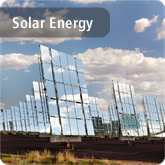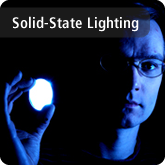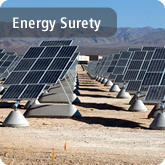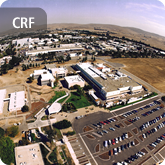Solid state lighting (SSL), which uses light-emitting diodes (LEDs), has the potential to be 10 times more energy efficient than traditional incandescent light bulbs. Currently, 20% of U.S. energy use powers lighting. SSL technology can potentially significantly cut U.S. lighting energy use, reducing electricity consumption for lighting by one-fourth. That’s why since 2003, the Department of Energy has invested with industry partners in research and development of LED technologies. While costs are dropping and many product improvements have been made, the work continues to make LED lighting a competitive option in more lighting applications.
As part of this national effort, Veeco, a leading equipment supplier, and Philips Lumileds, a SSL manufacturer, are working with Sandia National Laboratories to drive down the cost of high-brightness LEDs (HB-LEDs) by implementing process simulation tools and by improving temperature measurement and control methods to increase metal organic chemical vapor deposition (MOCVD) yield. MOCVD is the critical enabling technology for LED production.

Sandia technologist Jeff Kempisty removes an InGaN LED wafer from the Veeco MOCVD system.
The overall objective of this two-year program is to develop high-volume MOCVD systems that provide a four times reduction in the cost of epitaxial growth for LED devices, with the ultimate goal of a 10 times reduction in LED costs.
- Sandia is working with Veeco to more accurately predict MOCVD growth processes by combining Veeco’s expertise in fluid dynamic modeling with Sandia’s specific experience modeling III-nitride-based chemistry.
- Sandia has provided a prototype near-ultraviolet (UV) pyrometer that will be jointly developed with Veeco for use with Veeco’s production MOCVD reactors (because temperature is the primary driving force for the majority of reactions that take place in the LED growth process).
- Philips Lumileds is evaluating the UV pyrometer for accuracy and repeatability in a high volume LED manufacturing environment.
Veeco has already made improvements to its high-throughput MaxBright™ multireactor MOCVD system, with more to come. This means the partnership between Veeco and Sandia has already yielded results, and is well on its way to achieving its goal of driving down the cost of HB-LEDs, making them more competitive with existing lighting in order to reduce our country’s energy use.
Read more about the Veeco-ECIS partnership.
 ECIS Highlights
ECIS Highlights













 RSS
RSS Google+
Google+ Twitter
Twitter Facebook
Facebook LinkedIn
LinkedIn YouTube
YouTube Flickr
Flickr